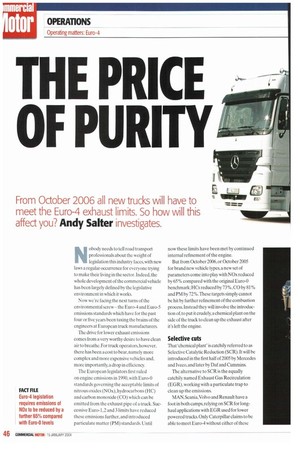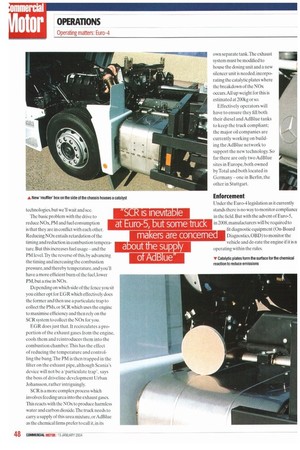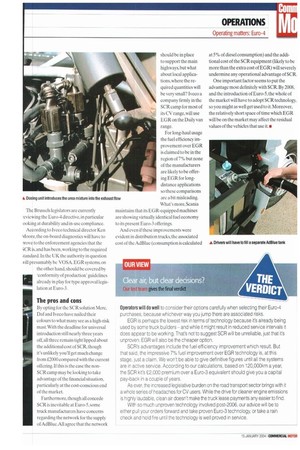THE PRICE OF PURITY
Page 50

Page 52

Page 53

If you've noticed an error in this article please click here to report it so we can fix it.
From October 2006 all new trucks will have to
meet the Euro-4 exhaust limits. So how will this
affect you? Andy Salter investigates.
Nobody needs to tell road transport professionals about the weight of legislation this industry faces, with new laws a regular occurrence for everyone trying to make their living in the sector. Indeed,the whole development of the commercial vehicle has been largely defined by the legislative environment in which it works.
Now we're facing the next turns of the environmental screw — the Euro-4 and Euro-5 emissions standards which have for the past four or five years been taxing the brains of the engineers at European truck manufacturers.
The drive for lower exhaust emissions comes from a very worthy desire to have clean air to breathe. For truck operators, however, there has been a cost to bear. namely more complex and more expensive vehicles and, more irnportantly.a drop in efficiency.
The European legislators first ruled on engine emissions in 1990, with Euro-0 standards governing the acceptable limits of nitrous oxides (N0x), hydrocarbons (HC) and carbon monoxide (CO) which can be emitted from the exhaust pipe of a truck. Successive Euro-1,2 and 3 limits have reduced these emissions further, and introduced particulate matter (PM) standards. Until now these limits have been met by continued internal refinement of the engine.
But from October 2006, or October 2005 for brand new vehicle types,a new set of parameters come into play with NOx reduced by 65% compared with the original Euro-0 benchmark; HCs reduced by 73%, CO by 81% and PM by 72 %.These targets simply cannot be hit by further refinement of the combustion process. Instead they will involve the introduction of, to put it crudely,a chemical plant on the side of the truck to clean up the exhaust after it's left the engine.
Selective cuts
That 'chemical plant' is catchily referred to as Selective Catalytic Reduction (SCR). It will be introduced in the first half of 2005 by Mercedes and Iveco, and later by Daf and Cummins.
The alternative to SCR is the equally catchily named Exhaust Gas Recirculation (EGR), working with a particulate trap to clean up the emissions.
MAN, Scania,Volvo and Renault have a foot in both camps, relying on SCR for longhaul applications with EGR used for lower powered trucks. Only Caterpillar claims to be able to meet Euro-4 without either of these technologies, hut we'll wait and see.
The basic problem with the drive to reduce NOx,PM and fuel consumption is that they are in conflict with each other. Reducing NOx entails retardation of the timing and reduction in combustion temperature. But this increases fuel usage — and the PM level.Try the reverse of this, by advancing the timing and increasing the combustion pressure, and thereby temperature, and you'll have a more efficient burn of the fuel,lower PM, but a rise in NOx.
Depending on which side of the fence you sit you either opt for EGR which effectively does the former and then use a particulate trap to collect the PMs, or SCR which uses the engine to maximise efficiency and then rely on the SCR system to collect the NOx for you.
EGR does just that. It recirculates a proportion of the exhaust gases from the engine, cools them and reintroduces them into the combustion chamber.This has the effect of reducing the temperature and controlling the bang.The PM is then trapped in the filter on the exhaust pipe, although Scania's device will not be a 'particulate trap'. says the boss of driveline development Urban Johansson, rather intriguingly.
SCR is a more complex process which involves feeding urea into the exhaust gases. This reacts with the NOx to produce harmless water and carbon dioxide.The truck needs to carry a supply of this urea mixture. or AdBlue as the chemical firms prefer to call it. in its own separate tank.The exhaust system must be modified to house the dosing unit and a new silencer unit is needed, incorporating the catalytic plates where the breakdown of the NOx occurs. All up weight for this is estimated at 200kg or so.
Effectively operators will have to ensure they fill both their diesel and AdBlue tanks to keep the truck compliant; the major oil companies are currently working on building the AdBlue network to support the new technology. So far there are only two AdBlue sites in Europe, both owned by Total and both located in Germany—one in Berlin, the other in Stuttgart.
Enforcement Under the Euro-4 legislation as it currently stands there is no way to monitor compliance in the field. But with the advent of Euro-5, in 2008,manufacturers will be required to fit diagnostic equipment (On-Board Diagnostics. OBD) to monitor the vehicle and de-rate the engine if it is operating within the rules. The Brussels legislators are current ly -eviewing the Euro-4 directive. in particular ooking at durability and in-use compliance.
According to Iveco technical director Ken vloore,the on-board diagnostics will have to wove to the enforcement agencies that the iCR is,and has been,working to the required itandard. In the UK the authority in question will presumably be VOSA. EGR systems.on the other hand,should be covered by 'conformity of production' guidelines already in play for type approval legislation at Euro-3.
The pros and cons By opting for the SCR solution Mere, Daf and Iveco have nailed their colours to what many see as a high-risk mast. With the deadline for universal introduction stilt nearly three years off. all three remain tight lipped about the additional cost of SCR, though it's unlikely you'll get much change from £2000 compared with the current offering. If this is the case the nonSCR camp may be looking to take advantage of the financial situation. particularly at the cost-conscious end of the market.
Furthermore, though all concede SCR is inevitable at Euro-5,some truck manufacturers have concerns regarding the network for the supply of AdBlue.All agree that the network o support the main lighways, but what about local applications, where the required quantities will Ile very small? Iveco a company firmly in the SCR camp for most of its CV range. will use LGR on the Daily van range.
For long-haul usage the fuel efficiency improvement over EGR is claimed to be in the region of 7% but none of the manufacturers are likely to be offering EGR for longdistance applications so these comparisons are a bit misleading.
What's more, Scania maintains that its EGR-equipped machines are showing virtually identical fuel economy to its present Euro-3 offerings.
And even if these improvements were evident in distribution trucks, the associated cost of the AdBlue (consumption is calculated at 5% of diesel consumption) and the additional cost of the SCR equipment (likely to be more than the extra cost of EGR) will severely undermine any operational advantage of SCR.
One important factor seems to put the advantage most definitely with SCR. By 2008. and the introduction of Euro-5. the whole of the market will have to adopt SCR technology. so you might as well get used to it. Moreover. the relatively short space of time which EGR will be on the market may affect the residual values of the vehicles that use it.•
































































































































































































